
Burton Stephen Lancaster was an American actor and film producer. Initially known for playing tough guys with a tender heart, he went on to achieve success with more complex and challenging roles over a 45-year career in films and television series. He was a four-time nominee for the Academy Award for Best Actor, and he also won two BAFTA Awards and one Golden Globe Award for Best Lead Actor. The American Film Institute ranks Lancaster as #19 of the greatest male stars of classic Hollywood cinema.

William Clark Gable was an American film actor. Often referred to as the "King of Hollywood", he had roles in more than 60 motion pictures in a variety of genres during a career that lasted 37 years, three decades of which was as a leading man. He was named the seventh greatest male movie star of classic American cinema by the American Film Institute.

Judy Garland was an American actress and singer. She attained international stardom and critical acclaim: as an actress in both musical and dramatic roles; as a recording artist; and on the concert stage. Renowned for her versatility, she received an Academy Juvenile Award, a Golden Globe Award, and a Special Tony Award. Garland won the Grammy Award for Album of the Year for her 1961 live recording, Judy at Carnegie Hall; she was the first woman to win that award.

Mickey Rooney was an American actor, producer, radio entertainer, and vaudevillian. In a career spanning nearly nine decades, he appeared in more than 300 films and was among the last surviving stars of the silent-film era. He was the top box-office attraction from 1939 to 1941, and one of the best-paid actors of that era. At the height of a career marked by declines and comebacks, Rooney performed the role of Andy Hardy in a series of 16 films in the 1930s and 1940s that epitomized the mainstream United States self-image.

Judgment at Nuremberg is a 1961 American epic legal drama film directed and produced by Stanley Kramer, and written by Abby Mann. It features Spencer Tracy, Burt Lancaster, Richard Widmark, Maximilian Schell, Werner Klemperer, Marlene Dietrich, Judy Garland, William Shatner, and Montgomery Clift. Set in Nuremberg, West Germany, the film depicts a fictionalized version – with fictional characters – of the Judges' Trial of 1947, one of the twelve Nuremberg Military Tribunals conducted under the auspices of the U.S. military in the aftermath of World War II.

The Academy Juvenile Award, also known informally as the Juvenile Oscar, was a Special Honorary Academy Award bestowed at the discretion of the Board of Governors of the Academy of Motion Picture Arts and Sciences (AMPAS) to specifically recognize juvenile performers under the age of eighteen for their "outstanding contribution[s] to screen entertainment".
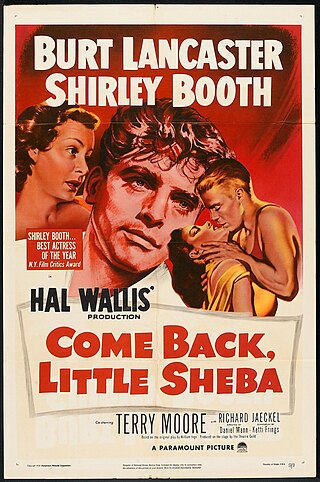
Come Back, Little Sheba is a 1952 American drama film directed by Daniel Mann in his directorial debut and produced by Paramount Pictures. The script was adapted by Ketti Frings from the 1950 play of the same title by William Inge. Starring Burt Lancaster, Shirley Booth, Terry Moore, and Richard Jaeckel, the film tells the story of a marriage between a recovering alcoholic and his frumpy wife, which is rocked when a young college student rents a room in the couple's house. The title refers to the wife's little dog that disappeared months before the story begins and whom she still openly grieves for. Booth, who had originated her role on Broadway and was making her film debut, won Best Actress honors at the Academy Awards, the Golden Globes, and the New York Film Critics Circle Awards.

John Nicholas Cassavetes was a Greek-American filmmaker and actor. He began as an actor in film and television before helping to pioneer modern American independent cinema as a writer and director, often producing and distributing his films with his own money. He received nominations for three Academy Awards, two BAFTA Awards, four Golden Globe Awards, and an Emmy Award.
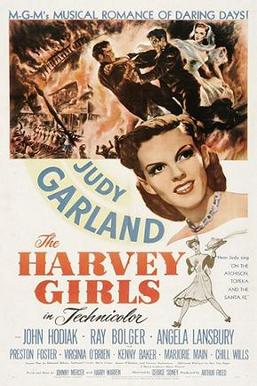
The Harvey Girls is a 1946 Technicolor American musical film produced by Arthur Freed for Metro-Goldwyn-Mayer. It is based on the 1942 novel of the same name by Samuel Hopkins Adams, about Fred Harvey's Harvey House waitresses. Directed by George Sidney, the film stars Judy Garland and features John Hodiak, Ray Bolger, and Angela Lansbury, as well as Preston Foster, Virginia O'Brien, Kenny Baker, Marjorie Main and Chill Wills. Future star Cyd Charisse appears in her first speaking role on film.
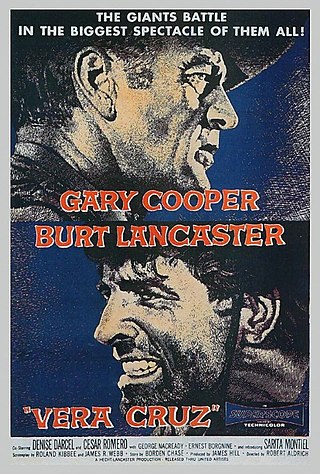
Vera Cruz is a 1954 American Western film directed by Robert Aldrich and starring Gary Cooper and Burt Lancaster, featuring Denise Darcel, Sara Montiel, Cesar Romero, Ernest Borgnine, Charles Bronson and Jack Elam. Set during the Franco-Mexican War, the film centers on a group of American mercenaries tasked with transporting a large shipment of Imperial gold to the port of Veracruz, but begin to have second thoughts about their allegiances. It was produced by Hecht-Lancaster Productions and released by United Artists on 25 December 1954.
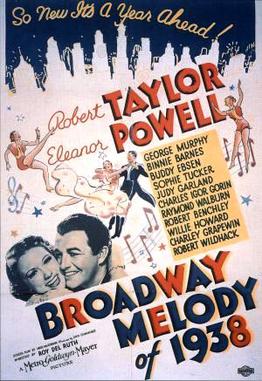
Broadway Melody of 1938 is a 1937 American musical film produced by Metro-Goldwyn-Mayer and directed by Roy Del Ruth. The film is essentially a backstage musical revue, featuring high-budget sets and cinematography in the MGM musical tradition. The film stars Eleanor Powell and Robert Taylor and features Buddy Ebsen, George Murphy, Judy Garland, Sophie Tucker, Raymond Walburn, Robert Benchley and Binnie Barnes.
Abby Mann was an American film writer and producer.
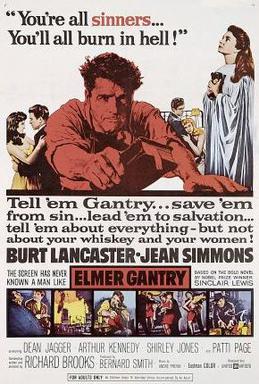
Elmer Gantry is a 1960 American drama film about a confidence man and a female evangelist selling religion to small-town America. Adapted by director Richard Brooks, the film is based on the 1927 novel of the same name by Sinclair Lewis, and stars Burt Lancaster, Jean Simmons, Arthur Kennedy, Shirley Jones and Patti Page.
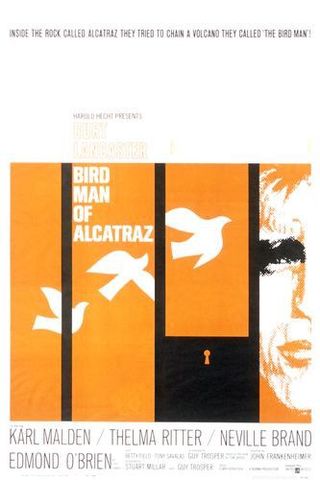
Birdman of Alcatraz is a 1962 American biographical drama film directed by John Frankenheimer and starring Burt Lancaster. It is a largely fictionalized version of the life of Robert Stroud, who was sentenced to solitary confinement after having killed a prison guard. A federal prison inmate, he became known as the "Birdman of Alcatraz" because of his studies of birds, which had taken place when he was incarcerated at Leavenworth Prison where he was allowed to keep birds in jail. When moved to Alcatraz, Stroud was never allowed to keep any birds.
Robert Clifford Jones was an American film editor, screenwriter, and educator. He received an Academy Award for the screenplay of the film Coming Home (1978). As an editor, Jones had notable collaborations with the directors Arthur Hiller and Hal Ashby. Jones was nominated three times for the Academy Award for Best Film Editing: It's a Mad, Mad, Mad, Mad World (1963), Guess Who's Coming to Dinner (1967), and Bound for Glory (1976).

Babes in Arms is the 1939 American film version of the 1937 coming-of-age Broadway musical of the same title. Directed by Busby Berkeley, it stars Mickey Rooney and Judy Garland, and features Charles Winninger, Guy Kibbee, June Preisser, Grace Hayes, and Betty Jaynes. It was Garland and Rooney's second film together as lead characters after their earlier successful pairing in the fourth of the Andy Hardy films. The film concerns a group of youngsters trying to put on a show to prove their vaudevillian parents wrong and make it to Broadway. The original Broadway script was significantly revamped, restructured, and rewritten to accommodate Hollywood's needs. Almost all of the Rodgers and Hart songs from the Broadway musical were discarded.

Everybody Sing is a 1938 American musical comedy film directed by Edwin L. Marin, and starring Allan Jones, Judy Garland and Fanny Brice, and featuring Reginald Owen and Billie Burke. The screenplay and story by Florence Ryerson and Edgar Allan Woolf had additional work by James Gruen and Milton Merlin with uncredited contributions from Bert Kalmar, Harry Ruby and Dalton Trumbo.

Too Late Blues is a 1961 black-and-white American film directed by John Cassavetes and starring Bobby Darin, Stella Stevens and Everett Chambers. It is the story of jazz musician "Ghost" Wakefield and his relationship with both his fellow band members and his love interest, Jess, a beautiful would-be singer. The film was written by Cassavetes and Richard Carr.

The Midnight Man is a 1974 American neo noir mystery film starring and co-directed by Burt Lancaster. The film also stars Susan Clark, Cameron Mitchell, Morgan Woodward, Harris Yulin, Robert Quarry, Joan Lorring, Lawrence Dobkin, Ed Lauter, Mills Watson, Charles Tyner and Catherine Bach.

Judy is a 2019 biographical drama film based on the life of American entertainer Judy Garland. Directed by Rupert Goold, it is an adaptation of the Olivier- and Tony-nominated West End and Broadway play End of the Rainbow by Peter Quilter. The film stars Renée Zellweger, Jessie Buckley, Finn Wittrock, Rufus Sewell, and Michael Gambon.

















